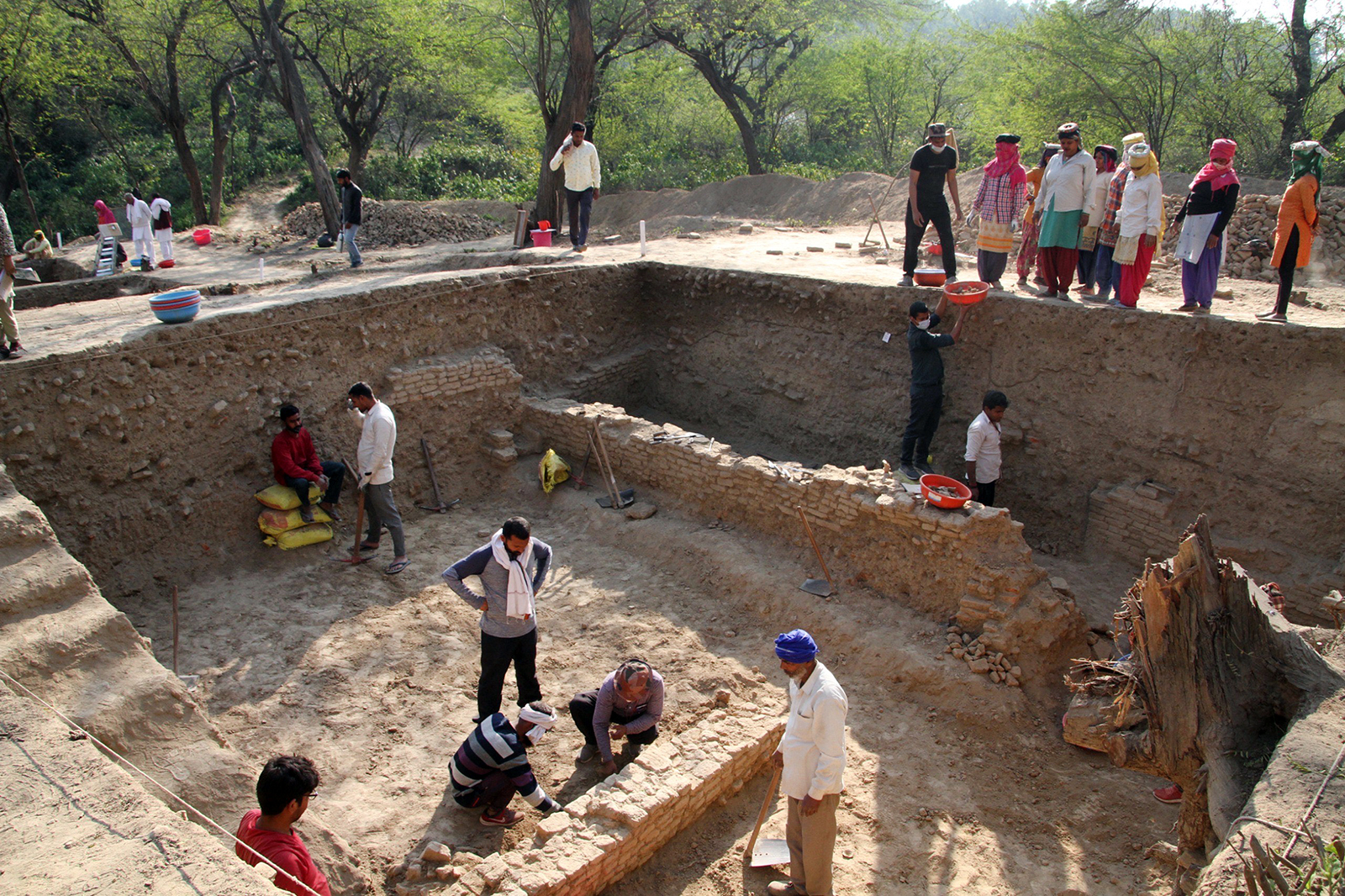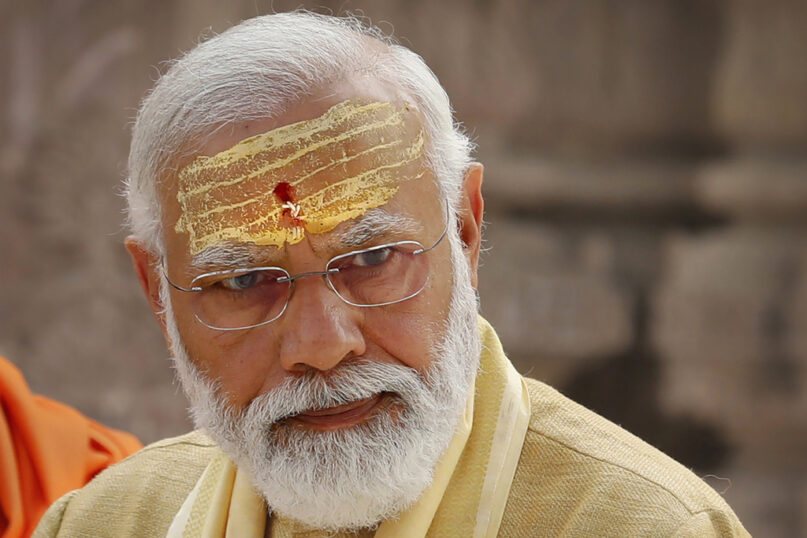
MEERUT, India (RNS) — In February 2024, Indian Prime Minister Narendra Modi donned scuba gear and dove off a small boat into the Arabian Sea to perform an underwater ceremony in what some archaeologists say are the submerged remains of the holy city of Dwarka.
“To pray in the city of Dwarka, which is immersed in the waters, was a very divine experience,” Modi told reporters afterward. “I felt connected to an ancient era of spiritual grandeur and timeless devotion.”
The problem, according to other experts of ancient India, is that the ruins beneath the waves off the coast of Gujarat have nothing to do with the city established by the Hindu deity Lord Krishna and found only in the Hindu epic the Mahabharata.
Modi’s subsurface devotions were part of a decade-long project to portray the Mahabharata as the true history of India — and an attempt, many Indians say, to boost ancient Hindu culture as a civilization equal in knowledge to any we have today. Soon after coming to power, Modi told an audience of scientists and physicians that the text’s description of one character from the epic as being “not born from a mother’s womb” meant that “genetic science was present at that time.”
Modi has also lavishly funded archaeological excavations to look for evidence of the existence of the epic’s fabled kingdoms. The Archaeological Survey of India, the government body overseeing the conservation of monuments and archaeological artifacts, has been digging at various sites across the country to discover evidence to substantiate the Hindu mythic epic.

Indian Prime Minister Narendra Modi has sandalwood paste and vermilion applied on his forehead during the inauguration of Kashi Vishwanath Dham Corridor, a promenade that connects the Ganges River with the centuries-old temple dedicated to Hindu god Shiva in Varanasi, India, Dec. 13, 2021. (AP Photo/Rajesh Kumar Singh, File)
According to a senior ASI official, the focus of the government-ordered work is on “dating Mahabharata, deepening the understanding of the Hindu civilizational history, and finding physical sites that would substantiate what the India’s majority Hindu community collectively knows and reveres.”
The Mahabharata, compiled between the third century B.C.E. and the third century C.E., chronicles the dynastic struggles between two groups of cousins, the Pandavas and the Kauravas, for control over the kingdom of Hastinapur, which shares the name of a city northeast of India’s capital, New Delhi. The epic comes with a huge cast of complex characters, as well as ideas on the human condition and morality, and culminates in a great destructive war.
It is a cornerstone of Indian mythology and culture, one that Romila Thapar, a historian of ancient India, says leaves the reader with moral dilemmas and lingering uncertainties.
Several senior ASI officials told Religion News Service that the government is keen to find solid proof of the Mahabharata period. “That’s why the ASI is promoting excavations. And funding is not a problem at all,” said an official who did not want to be named. The Modi government has allocated almost a third of the Ministry of Culture’s annual budget to focus on excavations, officials in the culture ministry said.
Among 51 sites the ASI has approved for new excavations are the Old Fort in Delhi, Sanauli, Barnawa and Hastinapur, in Uttar Pradesh, and Rakhigarhi in Haryana.
The most prominent of these is the Old Fort, or Purana Qila, a 16th-century architectural marvel built by the Mughal Emperor Humayun. According to the ASI’s conservation director, Vasant Swarnkar, who is overseeing the current excavations, the discovery of pottery belonging to the Painted Grey Ware culture suggests that the site buzzed with activity during the height of the Mauryan Empire, when the Mahabharata was being composed.

The Old Fort, or Purana Qila, in Delhi, India. (Photo by Kaiser Tufail/Wikimedia/Creative Commons)
But other experts cast doubt on any link between the Painted Grey Ware culture and the Mahabharata. ASI’s current director general, Y.S. Rawat, pointed to the difficulty in dating the events of the Mahabharata and said similar pottery has been found at many sites that have nothing to do with the epic.
Upinder Singh, a historian of ancient and early medieval Indian history, said the Painted Grey Ware artifacts in the Old Fort simply indicate that the site was inhabited during the Mauryan period.
Thapar goes further, arguing that the Mahabharata is an amalgamation of literary imagery and a symbolical narrative, and, while a reflection of ancient Indian society and culture, it should not be taken as a factual record of events.
But the Modi government and affiliated Hindu nationalists have already declared the historicity of the Mahabharata and are encouraging tourists to visit the sites as examples of settings of the mythic epic. The Old Fort has been handed over to the Civilization Foundation as part of the Ministry of Tourism’s “Adopt a Heritage” plan.
“All our tourist events, museums, interpretation centers and heritage walks at the site will be centered around the Mahabharata. We need to build the right narrative of the Old Fort,” said Ajay Verma, CEO of heritage and events at the Civilization Foundation.
Verma said the links between the Old Fort and Mahabharata have already been unearthed by the ASI and speculated that the site could have its origins in Indraprastha, the mythic capital of the Pandavas.

People at the Archaeological Survey of India excavation site of Hastinapur, May 30, 2025, in Meerut, northern India. (Photo by Mohammad Ali)
Excavations are going on in Hastinapur, which some believe was the capital of the Kuru kingdom in Mahabharata. ASI archaeologists claim to have discovered deposits associated with the Mahabharat period at a site in Baghpat, leading some to believe it to be the location of the “Lakshagriha” or “House of Lac” where the Pandavas are nearly burned alive in the story of the Mahabharata.
ASI’s excavations here have raised hopes for the discovery of a tunnel used by the Pandavas in their escape.
The Modi government has already identified Hastinapur to be developed as an “iconic site” and has proposed an Indian Institute of Heritage and Conservation under the Ministry of Culture, which would develop five archaeological sites as “iconic sites” with on-site museums.
Ongoing ASI excavations have also found ancient remains in the soil at Sanauli, in Uttar Pradesh’s Baghpat district. The archaeologists have found the burial site estimated to be as old as 2000 B.C., which would put it in the right time frame to be included in the Mahabharata. Chariots discovered at the site, meanwhile, hint that the people there were warriors skilled in arts and crafts.
The team of experts involved in that excavation said they have discovered ornamental coffin lids in three burial sites, embellished with floral designs and anthropological patterns. The swords unearthed at the site have copper coated hilts and a medial ridge, making these quite suitable for warfare activities. A torch, daggers and shields have also been dug up.
Certain officials of the ASI who are known to follow Hindu nationalism have already started asserting that parts of Mahabharata not only validated the archaeological excavations but were helpful in going about it.
